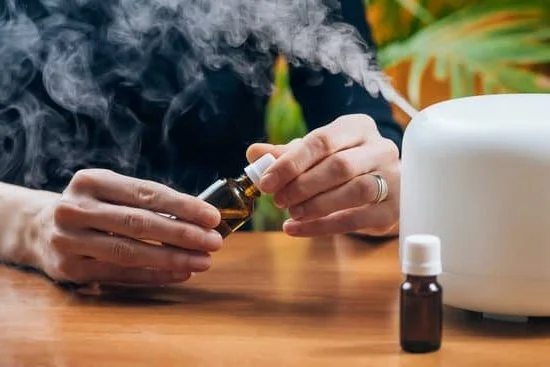is a common concern among pet owners who want the best for their furry companions. In this article, we will delve into the world of aromatherapy for dogs, exploring its potential benefits and risks, as well as providing guidance on safe practices.
Aromatherapy involves the use of essential oils derived from plants to improve physical and psychological well-being. These aromatic oils are often inhaled or applied topically with the intention of promoting relaxation or relieving symptoms such as anxiety and pain. While aromatherapy has shown positive effects on humans, its potential benefits for animals, including dogs, have also been an area of interest for pet owners and veterinarians alike.
Understanding how dogs perceive scent and the potential effects of aromatherapy on their wellbeing is crucial in determining whether it is suitable for them. Dogs have a highly developed sense of smell, making them particularly sensitive to scents in their environment. Certain essential oils can either positively or negatively impact dogs’ behavior and health. It is important to explore the topic further to ensure that any use of aromatherapy with dogs is done safely and responsibly.
Understanding Aromatherapy for Dogs
A dog’s sense of smell is far more powerful than that of humans. While humans have around 5-6 million olfactory receptors, dogs have approximately 125-300 million. This heightened sense of smell allows dogs to perceive scents more intensely and can influence their behavior and emotions. As a result, aromatherapy can have a significant impact on a dog’s wellbeing.
When using aromatherapy around dogs, it’s important to consider the potential effects it may have on them. Certain essential oils can be harmful to dogs if ingested, inhaled excessively, or applied directly to their skin. Some oils that are safe for humans, such as tea tree oil, peppermint, and citrus oils, can be toxic to dogs. These oils can cause symptoms such as vomiting, diarrhea, difficulty breathing, tremors, and even liver damage in severe cases.
On the other hand, there are essential oils that are considered safe for use around dogs when properly diluted and used in moderation. Lavender, chamomile, frankincense, and ginger are examples of essential oils that are generally safe for dogs and may provide calming or therapeutic effects. It’s important to always do thorough research or consult with a veterinarian before using any form of aromatherapy around dogs.
| Potential Effects | Examples |
|---|---|
| Toxic effects | Tea tree oil |
| Safe Oils | Lavender |
Potential Risks
When it comes to using aromatherapy for dogs, it is crucial to be aware of the potential risks and negative effects that certain essential oils can have on their wellbeing. While aromatherapy can be beneficial for dogs in some cases, there are essential oils that can be harmful and even toxic to them.
Toxic Essential Oils for Dogs
Some essential oils that are commonly used in aromatherapy for humans can be harmful to dogs when ingested, inhaled, or applied topically. These include but are not limited to tea tree oil, pine oil, cinnamon oil, citrus oils, pennyroyal oil, and wintergreen oil.
These essential oils can cause adverse reactions such as vomiting, diarrhea, difficulty breathing, liver damage, and neurological issues in dogs. It is important for dog owners to familiarize themselves with these toxic essential oils and avoid using them around their pets.
Sensitivity and Allergies
Just like humans, dogs can also have sensitivities and allergies to certain scents and essential oils. Some dogs may experience skin irritation or allergic reactions when exposed to certain fragrances or essential oils. It is essential for dog owners to monitor their pets’ reactions when using aromatherapy around them and discontinue use if any adverse effects are observed.
Proper Dilution and Application
Even essential oils that are considered safe for use around dogs should be properly diluted before being used in aromatherapy practices. Direct application of undiluted essential oils on a dog’s skin or fur can lead to irritation or toxicity. Additionally, excessive use of diffusers or direct inhalation of essential oil vapors by dogs should be avoided to prevent overexposure.
In summary, while aromatherapy can have benefits for dogs when used correctly with safe essential oils and proper dilution methods, it is important for dog owners to be mindful of the potential risks associated with certain essential oils. Consulting with a veterinarian before using aromatherapy with dogs is strongly recommended to ensure the safety and wellbeing of our canine companions.
Safe Essential Oils for Dogs
Aromatherapy is well known for its potential benefits in promoting relaxation and reducing stress in humans. However, it can also have positive effects on our furry friends. When it comes to using essential oils around dogs, it’s important to be mindful of the potential risks and safe practices. Here are some essential oils that are generally considered safe for use around dogs:
Lavender
Lavender is known for its calming properties and is often used to help alleviate anxiety in dogs. It can also promote better sleep and reduce stress levels.
Chamomile
Chamomile is another essential oil that can help calm anxious or stressed dogs. It can also aid in relieving stomach issues and promote relaxation.
Frankincense
Frankincense has anti-inflammatory properties that can benefit dogs with arthritis or joint pain. It can also promote a sense of calmness and wellbeing.
It’s important to note that while these essential oils are generally considered safe for use around dogs, they should always be diluted properly and used in moderation. Consulting with a veterinarian before introducing any new scents into your dog’s environment is crucial to ensure their safety and wellbeing.
When using aromatherapy around dogs, it’s best to stick with mild scents and avoid using potent oils like tea tree or eucalyptus, which can be harmful to dogs when not used properly. Always monitor your dog’s behavior when introducing new scents into their environment, and seek professional guidance if you have any concerns about using aromatherapy around your pet.
Aromatherapy Practices for Dogs
Aromatherapy is a holistic healing treatment that uses natural plant extracts to promote health and well-being. This practice involves using essential oils to stimulate the olfactory system, which can have positive effects on both humans and animals.
Dogs have a highly developed sense of smell, with up to 300 million scent receptors compared to a human’s 5 million. This makes them more sensitive to the effects of aromatherapy, so it is important to use this practice cautiously and responsibly.
When using aromatherapy with dogs, it is crucial to consider the proper ways to administer essential oils. Here are some safe practices for utilizing aromatherapy with dogs:
- Diffusing: Using a diffuser in a well-ventilated area can help disperse essential oils into the air, creating a calming environment for your dog.
- Topical application: Diluting essential oils with a carrier oil and applying them to specific areas of your dog’s body can offer targeted relief or relaxation.
- Creating a calming environment: By integrating aromatherapy into your dog’s surroundings, you can create a peaceful atmosphere that promotes overall well-being.
It is important to note that not all essential oils are suitable for use around dogs. Some oils can be harmful or even toxic to pets, so it is crucial to do thorough research and consult with a veterinarian before using any new essential oil around your dog. Additionally, always observe your dog’s behavior and physical reactions when introducing them to aromatherapy practices.
Overall, when used responsibly and under the guidance of a professional, aromatherapy can offer numerous benefits for dogs. By understanding the proper ways to use aromatherapy with dogs and being mindful of their sensitivities, pet owners can provide their canine companions with the potential positive effects of this holistic healing practice while ensuring their safety and well-being.
Benefits of Aromatherapy for Dogs
Aromatherapy has gained popularity as a holistic approach to improving health and well-being for both humans and animals. When it comes to dogs, aromatherapy can have potential positive effects on their anxiety, stress, and overall wellness. By using essential oils in a safe and controlled manner, dog owners can help promote a sense of calm and relaxation in their furry companions.
Reduction of Anxiety and Stress
Dogs, like humans, can experience anxiety and stress due to various factors such as separation, loud noises, or changes in their environment. Aromatherapy offers a natural way to alleviate these feelings by using specific essential oils known for their calming properties. Lavender, chamomile, and frankincense are examples of essential oils that are commonly used to help reduce anxiety in dogs. When diffused or applied topically in a diluted form, these essential oils can create a soothing atmosphere for dogs.
Overall Wellness Improvement
In addition to addressing anxiety and stress, aromatherapy can also contribute to the overall wellness of dogs. Certain essential oils possess antibacterial, antifungal, and anti-inflammatory properties that may benefit dogs’ physical health. For example, tea tree oil is known for its antimicrobial properties and may aid in treating minor skin irritations or insect bites in dogs when used appropriately. Additionally, peppermint oil is often used to alleviate nausea or digestive issues in dogs when diluted properly.
Promotion of Relaxation
Creating an environment with pleasant scents through the use of aromatherapy can promote relaxation for dogs. By diffusing calming essential oils such as bergamot or ylang-ylang during stressful situations like thunderstorms or fireworks displays, dog owners can help their pets feel more at ease. The gentle aroma from these essential oils can have a soothing effect on dogs’ nerves, contributing to an overall sense of well-being.
Consultation With a Veterinary Professional
Aromatherapy, a practice that uses essential oils and aromatic compounds to improve physical and psychological well-being, is typically associated with human use. However, it is also gaining popularity in the realm of pet care, including for dogs.
While aromatherapy can potentially offer benefits to dogs, it is important to recognize that not all essential oils are safe for canine use. Therefore, it is crucial for dog owners to seek guidance from a veterinary professional before using aromatherapy on their pets.
Dogs have an incredibly strong sense of smell, often tens of thousands of times more acute than humans. As such, they can be particularly sensitive to the effects of essential oils and aromatherapy practices. Certain essential oils can pose potential risks and negative effects on dogs if used improperly or without proper knowledge. Some essential oils that are safe for humans can be toxic to dogs when ingested or even when simply being exposed through diffusers.
It is vital for dog owners to consult with a veterinarian before introducing any form of aromatherapy to their pets. A veterinary professional can provide guidance on safe practices and recommend specific essential oils that are suitable for dogs. They can also assess individual factors such as the dog’s age, breed, health conditions, and any potential allergic reactions before recommending any specific aromatherapy treatments.
| Potential Risks of Aromatherapy for Dogs | Safe Essential Oils for Dogs |
|---|---|
| Some essential oils can be toxic to dogs if ingested or inhaled | Lavender oil: known for its calming properties |
| Dogs may have allergic reactions to certain essential oils | Chamomile oil: helps with anxiety and sleep disturbances |
| Improper use of essential oils can lead to skin irritations in dogs | Frankincense oil: aids in relaxation and promotes overall well-being |
Conclusion
In conclusion, the use of aromatherapy for dogs can have both positive and negative effects, depending on the type of essential oils used, the method of application, and the individual dog’s sensitivity. While there are potential benefits of using aromatherapy to promote relaxation, reduce anxiety, and improve overall wellness in dogs, it is important for pet owners to be cautious and well-informed about the potential risks involved.
Consulting with a veterinary professional before using aromatherapy on dogs is crucial to ensure the safety and wellbeing of our furry companions.
It is essential to carefully consider the specific needs and sensitivities of each dog when using aromatherapy. Some essential oils that are safe for humans can be toxic or irritating to dogs, so it is important to do thorough research and consult with a veterinarian before introducing any new scents into a dog’s environment. Additionally, practicing safe methods of diffusing or applying essential oils around dogs is crucial in preventing any adverse reactions.
Ultimately, whether or not aromatherapy is “bad” for dogs depends on how it is used. When done correctly and under the guidance of a veterinary professional, aromatherapy can be a beneficial tool for promoting the wellbeing of our canine companions. However, caution should always be exercised when using essential oils around pets, and pet owners should prioritize their dog’s safety and comfort above all else.
Frequently Asked Questions
What Essential Oils Are Safe for Dogs to Smell?
Some essential oils safe for dogs to smell are lavender, chamomile, and frankincense. These oils can have a calming effect on dogs and can be diffused in the air for them to enjoy.
What Essential Oils Are Safe for Dogs Skin?
When it comes to essential oils safe for dogs’ skin, coconut oil and lavender oil are popular choices. However, it’s important to always dilute these oils and perform a patch test before applying them to a dog’s skin.
What Essential Oils Are Safe Around Pets?
Essential oils that are generally safe around pets include cedarwood, helichrysum, and cardamom. These oils can be used in a diffuser or diluted with water for use around pets, but it’s crucial to ensure proper ventilation and not overexpose them to the scent.

Are you looking for a natural way to improve your health and wellbeing?
If so, aromatherapy may be the answer for you.





